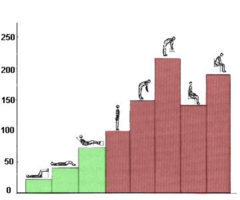The word “creep” already has a negative connotation in various settings, and the anatomical definition of creep can be just as ugly. Creep refers to the progressive deformation of bodily structures which occurs when the structures are under a constant load they were not designed to handle.¹
It might be helpful to think of creep in terms of something like a piece of rubber. If you repeatedly or consistently pull, stretch or hold the piece of rubber tight in ways it was not designed to be held for prolonged periods, the rubber is not happy. It may eventually stretch, become deformed and no longer be able to bounce back into shape. The same thing can happen to structures throughout your body, especially the muscles and tissues in your back.
Creep in Action
Folks who sit stooped over a computer all day are prime examples of creep in action, thanks to the unnatural load consistently placed on the soft tissues surrounding their spine. When you sit stooped forward or otherwise subject your spine to a forward bending motion, you’re engaging in what is known as spinal flexion. Subjecting your body to prolonged or repetitive periods of spinal flexion can eventually result in a host of negative effects.
One of these effects is the impairment of your sensorimotor control mechanisms.² Your sensorimotor control mechanisms are responsible for reflex control of your spinal movements, based on input they receive from sensory neurons in your spinal tissues.² These include the muscles, ligaments, fascia and joint capsules surrounding your spine as well as the spinal discs between your vertebrae.²⁻⁷

Least pressure on disk is laying down with feet up or in a semiflexed. Worst is sitting in a forward slump posture.
In a perfect world with equally perfect posture, the sensorimotor control mechanisms work in conjunction with muscle and tendon reflexes to coordinate the activation of muscles in your trunk area. They activate muscles as needed to limit the spine’s movement and prevent excessive loading.²
When that thing called creep kicks in due to prolonged or repetitive spinal flexion, however, your spine no longer enjoys its built-in system of protection.² Your back muscles are no longer able to properly protect your spine while your trunk becomes less rigid and less stable.⁸
This can happen from constant stooping, constantly bending forward to garden or lift heavy objects, or holding any other unnatural posture or position for extended periods.⁸ Creep is not limited to the forward bending of your spine, either. The same effect can happen if you position your spine in prolonged periods of twisting.⁹ All this creep can add up to back pain, an increased risk of injury and even back deformities.¹⁰
What You Can Do
Being aware of creep and its effect on your body can be the first step in helping to halt or correct it. If you know constant stooping, twisting or repetitive lifting can result in creep, you can try to reduce those specific behaviors. Allowing your body to rest and recover from creep-inducing activities throughout the day can also help, provided the rest periods are long enough to have an effect. One study showed that 20 minutes of recovery is not enough to help, although longer recovery periods may be.¹¹
Another option may be to perform exercises or activities that increase the muscle activation of the trunk muscles to make up for the accumulated effects of creep.⁸ ¹² ¹³ Exercises that help stabilize and strengthen your trunk muscles, such as Pilates or Foundation Training, may help keep the ill effects of creep at bay.
References
- McGill SM, Brown S. Creep response of the lumbar spine to prolonged full flexion. Clin Biomech. 1992;7:43-46.
- Sanchez-Zuriaga D, Adams MA, Dolan P. Is Activation of the Back Muscles Impaired by Creep or Muscle Fatigue? Spine. 2010;35(5):517–525.
- Yamashita T, Minaki Y, Oota I, et al. Mechanosensitive afferent units in the lumbar intervertebral disc and adjacent muscle. Spine. 1993;18:2252-6.
- Roberts S, Eisenstein SM, Menage J, et al. Mechanoreceptors in intervertebral discs. Morphology, distribution, and neuropeptides. Spine. 1995;20:2645–51.
- Rhalmi S, Yahia LH, Newman N, et al. Immunohistochemical study of nerves in lumbar spine ligaments. Spine. 1993;18:264-7.
- Yahia L, Rhalmi S, Newman N, et al. Sensory innervation of human thoracolumbar fascia. An immunohistochemical study. Acta Orthop Scand. 1992;63:195-7.
- McLain RF, Pickar JG. Mechanoreceptor endings in human thoracic and lumbar facet joints. Spine. 1998;23:168-73.
- Toosizadeh N, Bazrgari B, Hendershot B, Muslim K, Nussbaum MA, Madigan ML. Disturbance and recovery of trunk mechanical and neuromuscular behaviours following repetitive lifting: influences of flexion angle and lift rate on creep-induced effects. Ergonomics. 2013;56(6):954-963.
- Shan X, Ning X, Chen Z, Ding M, Shi W, Yang S. Low back pain development response to sustained trunk axial twisting. Eur Spine J. Published Online: 24 April 2013.
- Luo J, Pollintine P, Gomm E, Dolan P, Adams MA. Vertebral deformity arising from an accelerated ‘‘creep’’ mechanism. Eur Spine J. 2012;21:1684-1691.
- Muslim K, Bazrgari B, Hendershot B, Toosizadeh N, Nussbaum MA, Madigan ML. Disturbance and recovery of trunk mechanical and neuromuscular behaviors following repeated static trunk flexion: Influences of duration and duty cycle on creep-induced effects. Appl Ergon. 2013;44:643-651.
- Marras WS, Granata KP. Changes in Trunk Dynamics and Spine Loading During Repeated Trunk Exertions. Spine. 1997;22(21):2564-2570.
- Olson MW, Li L, Solomonow M. Interaction of Viscoelastic Tissue Compliance with Lumbar Muscles During Passive Cyclic Flexion-Extension. J Electromyogr Kinesiol. 2009;19(1):30-38.
